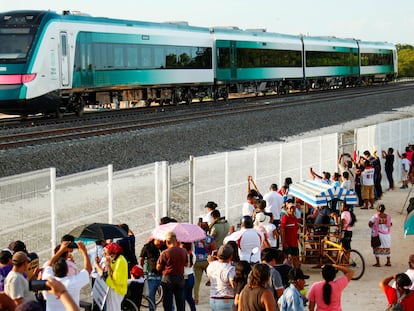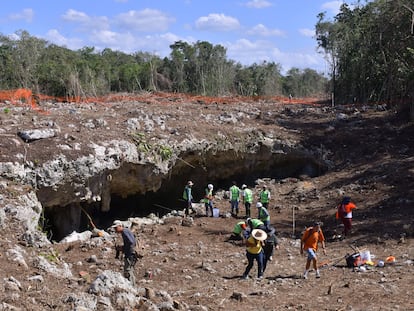On board the first Maya Train: The locomotive is modern but incomplete and guarded by helicopters
EL PAÍS climbs aboard with President López Obrador for the inauguration of his pet project, with a route from Campeche to Cancún that still lacks connections, garages and workmanship
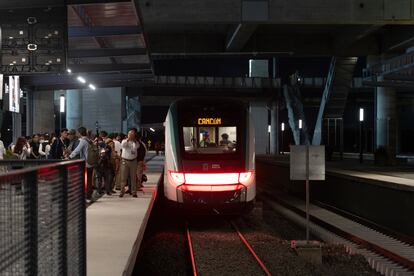

Andrés Manuel López Obrador looks out the window. On the other side, there are kilometers of lush jungle. Leaning between two train seats, the president’s hair is tousled and he’s wearing a white guayabera shirt. “This is how you can appreciate other places in the country. Here there are jaguars, deer, peacocks, armadillos, macaws... all kinds of species,” he says proudly. He is aboard the Maya Train, surrounded by journalists, on the trip he promised he would make five years ago. This Friday, the president inaugurated his government’s pet project, a modern but incomplete work that has been opened with unfinished stations, depots and connections; the convoy barely exceeds 110 kilometers (about 68 miles) per hour; and it operates under the watchful eye of Army helicopters. This unfinished train is the president’s controversial vehicle for lifting a region out of poverty.
The trip starts at 10:30 a.m. from the newly opened Santiago de Campeche station. The President rides in the first car, sharing a table with the Secretary of Defense, Luis Cresencio Sandoval; the head of the Navy, Admiral José Rafael Ojeda Durán; and businessman Carlos Slim. There is a retinue of ministers, governors, military and businessmen on board the locomotive that has been Lopez Obrador’s obsession in recent years. Nobody wants to miss its debut.
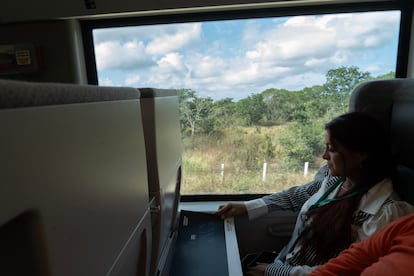
Layda Sansores is traveling in an individual seat next to the president. A few hours earlier, the governor of Campeche had foreshadowed what she believes was the origin of everything. It was 2014 and López Obrador had just survived a heart attack; on February 28, he climbed to the top of one of the Calakmul Reserve’s pyramids. There, he envisioned a train connecting a peninsula riddled with jungles, linked by a very delicate system of caves and cenotes; he imagined laying tracks where protected species live: “I am sure that the legend of the Mayan Train was born there, in the middle of the jungle; the prophecy was born there.”
The trip through the Tenabo, Hecelchekán, Calkiní, Maxcanú and Umán goes by quietly. From the window, the stops look simple; the facades are finished, but bulldozers and workers are still active behind them. Nearly 100,000 employees have participated in the effort to get this gigantic project ready, which, when completed in February next year, will cross five states and cover more than 1,550 kilometers (963 miles). Still wearing helmets and vests, the workers record the convoy’s passage. They wave and smile. It is thanks to them and their marathon workdays that the train is moving.
The train takes 1 hour and 50 minutes to get to Teya-Mérida in the Yucatán. That’s half an hour less than the time it takes by bus. The president’s supporters in the train car celebrate; it is really paying off. On some sections of the track, the train’s speed slows to 45 kilometers (about 28 miles) per hour, although for most of the trip, it goes around 110 kilometers (about 68 miles) per hour. It will not go much faster during this pre-opening, the director of the Mayan Train, General Óscar Lozano, tells EL PAÍS. As it gains ground, the idea is that it will reach 160 kilometers (99.4 miles) per hour. Why not faster? The general explains that the track is prepared for that speed, but not the systems, because that is not the goal for the moment.
The train’s proponents have comfort and safety in mind. The Maya Train is comfortable and spacious. Its interior, decorated in blue and green hues to “imitate the feeling of the sea,” is reminiscent of Spanish convoys, according to Alston, the company in charge of manufacturing the train. It has large windows, a tray, sockets and a good backrest. This is the basic version, which costs 1,166 pesos per ticket per trip. A first-class ticket costs over 1,800 pesos. That is between $70 and $100 in a region where over 40% of the population lives below the poverty line. A discount for nationals was announced at one point, but it has not yet gone into effect. The President’s intention is that it should be less than the price of the bus ticket, “even if it is just [by] a little.”
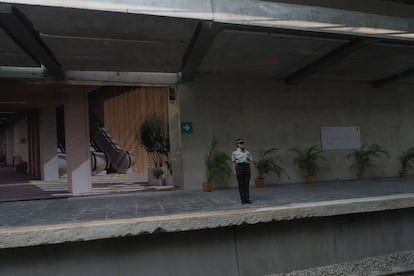
Mérida is the only big city that has also inaugurated a train connection branch to downtown—neither the Campeche station (14 kilometers/8.7 miles away) nor the Cancún station (17 kilometers/10.6 miles away, have public transportation to get there. After Mérida, the jungle becomes thicker. Ceiba trees appear, along with the Yucatecan green. On the straight stretch between Tixkokob and Izamal, the president appears. Far removed from the normal morning protocol, López Obrador is optimistic.
-Mr. President, the train is still lacking, the accesses are not complete, journalists say.
-Oh, no, of course, it is not finished. It’s a bit like what happened with the Felipe Ángeles [International Airport, AIFA], when they said that not even flies could stop there, that there was only one lady selling tlayudas [a tortilla-based food], because the AIFA is now the airport that transports the most cargo in the entire country. But these are works that take time, like everything in life. We crawled and then walked until we could run.
According to the Ministry of Finance, the Mexican government has already disbursed 400 billion pesos ($23,252,434,000) for this project, almost three times more than anticipated. And there is still another 74 billion pesos ($4,301,700,290) to go before the end of next year. López Obrador estimates that the train will reach “a break-even point” within three or four years. For the time being, they expect some 6,600 people to use this train each day during the initial stage. “We have to take care of the train,” he says.
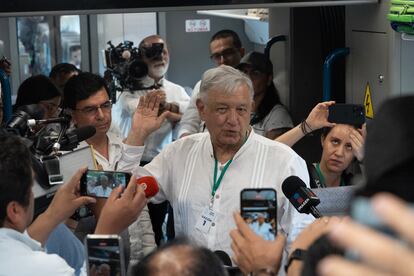
As the president speaks, helicopters patrol overhead. There will be four of these military vehicles protecting the operation every day, along with nearly 3,000 members of the National Guard stationed on the trains and in vans outside. “[There’s] security by land and air,” the president says. López Obrador is explaining why he decided to take the project away from the National Tourism Development Fund (FONATUR) and give it to the Armed Forces instead, which he has already done with 19 airports, for example. “I was thinking about who it would be more difficult to take the train away from and who would defend it more, to avoid its privatization: communications? FONATUR? Or [the Ministry of] Defense,” the president says. “Everything is considered in those terms; it is not to militarize [the train]; it is to leave a national asset in the hands of an institution that acts with discipline.″
When the president leaves, the train is passing through Chichén Itzá and traveling the final stretch: Valladolid, Nuevo Xcán, Leona Vicario and Cancún airport. It is raining outside, but dozens of residents stand on bridges or next to the tracks, waiting to observe the first journey of a train that they have been told will change their lives.

Sign up for our weekly newsletter to get more English-language news coverage from EL PAÍS USA Edition
Tu suscripción se está usando en otro dispositivo
¿Quieres añadir otro usuario a tu suscripción?
Si continúas leyendo en este dispositivo, no se podrá leer en el otro.
FlechaTu suscripción se está usando en otro dispositivo y solo puedes acceder a EL PAÍS desde un dispositivo a la vez.
Si quieres compartir tu cuenta, cambia tu suscripción a la modalidad Premium, así podrás añadir otro usuario. Cada uno accederá con su propia cuenta de email, lo que os permitirá personalizar vuestra experiencia en EL PAÍS.
¿Tienes una suscripción de empresa? Accede aquí para contratar más cuentas.
En el caso de no saber quién está usando tu cuenta, te recomendamos cambiar tu contraseña aquí.
Si decides continuar compartiendo tu cuenta, este mensaje se mostrará en tu dispositivo y en el de la otra persona que está usando tu cuenta de forma indefinida, afectando a tu experiencia de lectura. Puedes consultar aquí los términos y condiciones de la suscripción digital.
More information
Archived In
Últimas noticias
Tiger Woods turns 50: Will he continue playing on the PGA Tour or take a back seat?
The surreal journey of James Nnaji, the Barcelona youth player selected in the NBA Draft who ended up in the NCAA
Trump claims peace in Ukraine is near, but Moscow suggests otherwise
A survivor’s account of the Interoceanic Train accident: ‘We were scared because of the speed on the curve’
Most viewed
- Oona Chaplin: ‘I told James Cameron that I was living in a treehouse and starting a permaculture project with a friend’
- Reinhard Genzel, Nobel laureate in physics: ‘One-minute videos will never give you the truth’
- Why the price of coffee has skyrocketed: from Brazilian plantations to specialty coffee houses
- Pablo Escobar’s hippos: A serious environmental problem, 40 years on
- Chevy Chase, the beloved comedian who was a monster off camera: ‘Not everyone hated him, just the people who’ve worked with him’
